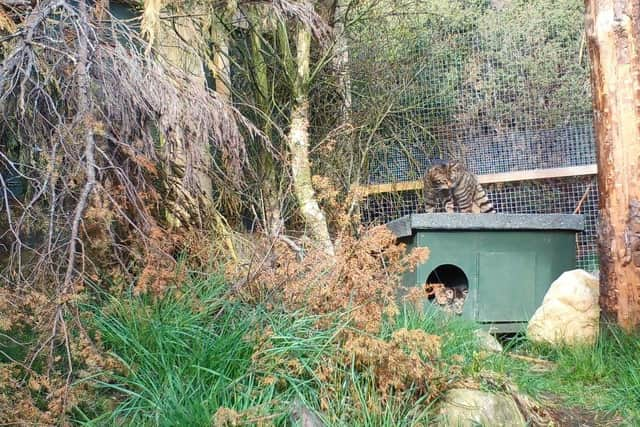Watch: Adorable wildcat kittens frolic in the Highlands, unaware future of the species is riding on their backs
A total of eight fluffy furballs have arrived in three litters at the Highland Wildlife Park at Kincraig, near Newtonmore.
They are the offspring of wildcats that were specially selected to be part of a ground-breaking conservation breeding programme, Saving Wildcats, which is based at the park.
The proud new mums are named Droma, Caol Ila and Torr.
Advertisement
Hide AdAdvertisement
Hide AdAnd it is hoped there will be the pitter-patter of more tiny paws in the near future.
The Scottish wildcat, often dubbed the Highland tiger, is the UK’s only native cat, but also its rarest and most threatened mammal.
The species, Felis silvestris, was once widespread, but persecution and hybridisation through interbreeding with domestic and feral cats have virtually wiped it out.


Estimates suggest as few as 35 – if any – genetically pure individuals remain in the wild, all in the Highlands.
This has led to the cats being declared “functionally extinct” in this country.
As part of the Saving Wildcats project, which is led by the Royal Zoological Society of Scotland (RZSS) and involves partners across Europe, 16 wildcats demonstrating good genetic purity were paired up earlier this year.
The plan is to raise a new generation that can be released into areas suitable for the animals to thrive and spread.
“Put simply, these kittens are the future of wildcats in Scotland,” said David Barclay, conservation manager for Saving Wildcats.
Advertisement
Hide AdAdvertisement
Hide Ad“Decades of extensive research have shown their species is highly likely to go extinct in Britain if we do not carry out releases to restore our critically endangered wildcat population.
“It is still early days for our new wildcat kittens, who are very vulnerable in their first weeks and months.
“They have a lot to learn over the next year, but our expert Saving Wildcats keepers will be on hand to help prepare them for the many challenges of life in the wild.”
The team uses a “a very hands-off approach” with the cats to give them the best possible chance of survival after release, monitoring them on remote cameras so they don’t become too tame and familiar with humans.
Dr Helen Senn, head of conservation and science at RZSS, said, “Wildcats are Scotland's most iconic animal, but sadly also one of our most endangered.
“Habitat loss, hunting and inter-breeding with domestic cats have all taken their toll, leaving this incredible species on the brink of extinction.
“Fortunately, our Saving Wildcats team, partners and many other wonderful supporters are working together to restore wildcats in the Highlands.”
The first releases are due to take place in Cairngorms National Park next year, subject to a translocation license being granted.
Advertisement
Hide AdAdvertisement
Hide AdSaving Wildcats partners include NatureScot, Forestry and Land Scotland, Cairngorms National Park Authority, Norden’s Ark and Spain’s Consejería de Medio Ambiente y Ordenación del Territorio de la Junta de Andalucía.
Funding for the six-year project comes from the European Union’s LIFE Programme; Garfield Weston Foundation, National Trust for Scotland; People’s Trust for Endangered Species; and European Nature Trust.
Comments
Want to join the conversation? Please or to comment on this article.
